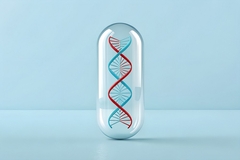DSM eyes HMOs’ potential for personalizing infant formula
The multinational is also exploring HMOs for an adult market

18 Jan 2021 --- DSM is bringing its new emphasis on personalization to the human milk oligosaccharide (HMO) arena. Louise Vigsnaes, head of biology in HMO innovation and business development at DSM, tells NutritionInsight that there could be an opportunity to personalize infant formula for individual mothers who cannot or choose not to breastfeed.
“If industry can build a comprehensive picture of HMO structures in each woman’s breast milk – particularly those found in abundance – it may be possible to produce personalized formula more accurately, containing specific HMO structures that mimic their own milk,” she explains.
This would be highly desirable as the composition of HMOs varies significantly between each mother and is as unique as a fingerprint. It changes across the lactation period and may be influenced by external factors, such as maternal age, weight and diet.
Although genes are widely thought to be a major influencer in determining HMO composition, emerging evidence also suggests that regional and ethnicity factors could play a part in the composition.
In September, Quantum Hi-Tech Biological (QHT) researchers found that Chinese mothers are less likely to secrete 2’-FL than North and South American populations but more likely than African populations.
Chinese uncertainty
Vigsnaes details that an increasing number of HMOs are considered safe and are permitted for use in infant nutrition products in many parts of the world, including Europe and North America. This is as they pass the efficient regulatory frameworks for risk assessment that are in place in these regions.
“They are classified as novel foods – as individually manufactured HMOs had no history of use before their approval – and are produced by biotechnology using genetically modified microorganisms (GMM). HMOs are highly purified ingredients with no trace of the microorganism used for production present in the end product.”
However, HMOs are not yet allowed in Chinese offerings, and Vigsnaes notes that approval may be further delayed due to the COVID-19 pandemic.
“While no regulatory pathway for novel foods produced by biotechnology currently exists in China, we expect that the relevant authorities will ultimately approve HMOs due to their clear nutritional and developmental benefits for infants. However, timing is unclear as all new compounds must pass rigorous safety and suitability assessments before approval.”  COVID-19 may have further set back China’s potential approval of HMOs.
COVID-19 may have further set back China’s potential approval of HMOs.
Improving formula
HMOs are the third most abundant breast milk component and are considered essential nutrients for optimal infant growth and development. Further research on identifying and reproducing the different HMO compositions throughout the lactation period will support infant formula development, notes Vigsnaes.
“An example of such research is determining the correct amount of the HMOs 2’FL and LNnT needed in infant formula to provide the right health benefits at the right time.”
Another consideration when developing infant formula is that breast milk contains much more than HMOs alone. There is a wide range of additional nutrients that a mother produces in her milk, which may be challenging to replicate.
“Despite these considerations, progress has already been made in this area, and emerging research indicates a promising outlook for the use of HMOs in infant nutrition. A clinical trial, for example, indicated that 2’FL and LNnT are safe and well-tolerated in infant formula, with lower rates of parent-reported morbidity (particularly bronchitis) and medication use,” explains Vigsnaes.DSM is able to produce 10 HMOs, six of which are currently commercially available.
Two key HMOs
Some of the most widely industry-produced HMOs are 2’FL and LNnT. They were also the first to be made available on the market.
“This is because they are two of the most abundant HMOs found in breast milk, and they also represent two of the fundamental structural classes. These products have received widespread regulatory approval confirming their safety for use individually or in combination in infant and follow-on formula,” she continues.
Following its Glycom acquisition, DSM is able to produce 10 HMOs, six of which are currently commercially available.
Notably, over 200 structurally different HMOs have been detected to date, although typically less than 20 to 25 HMOs make up more than 90 percent of the HMO biomass. The study of HMOs according to their impact began in the late 1950s, and they have been included in clinical trials since 2014.
Vigsnaes says further research needs to be conducted on the differences between all the structures and their potential health benefits for infant health and development before determining the benefit of producing hundreds of HMOs.
Beyond infants
DSM is also looking at the potential of HMOs for the adult market. The company is currently focusing on innovating in digestive, immune and brain health, with a range of products targeting adults.
Vigsnaes says that the research behind the impact of HMOs on gut health, in particular, is well-established.
“They have been found to promote the growth of beneficial bacteria in establishing a protective gut microbiota. This is paving the way for product innovation in the gut health market.”
She anticipates that as consumers become more aware of HMOs’ health benefits, products containing HMOs – in combination with other ingredients, such as vitamins, minerals and probiotics – targeted at specific health areas, will grow in popularity.
By Katherine Durrell












